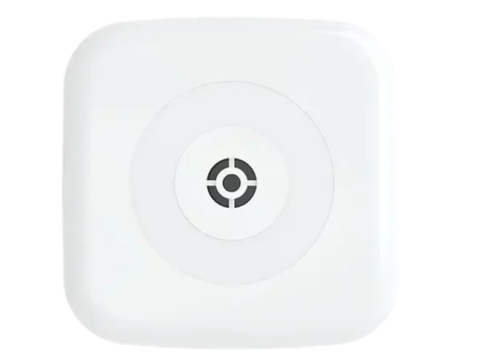Acoustic (sound-based) security sensors—often called glass-break detectors—are engineered to detect the shattering of glass in windows, storefronts, or decorative doors. Unlike motion sensors or magnetic contacts, acoustic detectors rely on analyzing specific sound frequencies generated by breaking glass. In this guide, we’ll discuss their key features, technical specifications, and best practices for installation and connection.
How Acoustic Glass-Break Sensors Work
Surface Detection Principle
- Acoustic detectors cover a surface zone rather than the entire volume of a room.
- They “listen” for the distinctive sound signature of breaking glass—a combination of low-frequency impact noise and the high-frequency “shatter” from glass fragments.
Sensor Components
- Microphone: Captures ambient noise in the monitored area.
- Signal Processor: Analyzes sound patterns, filtering out normal room noise.
- Output (Relay or Digital Signal): Triggers the alarm panel or wireless hub when the sensor recognizes the glass-break profile.
Wired vs. Wireless
- Wired sensors connect to the security panel’s alarm loop (often via relay outputs with “on/off” states).
- Wireless sensors use radio transmitters to communicate with a compatible control panel or hub. They typically run on battery power and are addressable, sending more detailed status updates (e.g., tamper, low battery, etc.).
Technical Specifications & Considerations
Range & Viewing Angle
- Most glass-break sensors claim about 6 meters (20 feet) of detection range and a 120° coverage angle.
- Actual performance can vary with the thickness or type of glass and acoustic properties of the room.
Glass Types
- Certain models specify which glass thicknesses and compositions (e.g., tempered, laminated, wire-reinforced) they support.
- If a window is film-coated or has special lamination, high-frequency sounds may be dampened, potentially preventing an alarm.
Dual-Frequency Analysis
- To minimize false alarms, modern detectors analyze both low-frequency (impact) and high-frequency (shattering).
- While effective, it can fail if the glass doesn’t fully break (e.g., film keeps fragments from falling).
Adjustable Sensitivity
- Many detectors have sensitivity knobs or DIP switches to accommodate different room acoustics and glass thicknesses.
- Some have swiveling microphones (dual-position designs) for better aiming.
Electrical & Environmental Ratings
- Voltage and current requirements (for wired sensors).
- Wireless Frequency for radio transmitters.
- Operating Temperature range.
- Indoor or weatherproof housing.
Installation & Mounting Tips
Select Proper Placement
- Ensure all points of the protected glass are within the sensor’s rated distance and angle.
- Common mounting spots: ceilings, walls, or window frames (soffits).
Ceiling Mount
- Can cover multiple windows if they fall within the sensor’s detection radius.
- Conceals cables nicely above a drop ceiling (e.g., “Armstrong” grid).
- Potential issue: thick drapes or blinds can muffle the sound.
Wall/Frame Mount
- Mounting on window recesses (soffits) or close to the glass ensures minimal sound dampening from curtains.
- Downsides: may have limited space; must avoid obstructing window operation; must confirm no “blind spots” outside the angle of coverage.
Wireless Sensors
- Same acoustic placement rules apply.
- Additional constraints: radio signal path to the control panel, battery access for replacements.
False Alarm Mitigation
- Sensors may misinterpret loud noises (e.g., dropped metal objects, slamming doors) as glass-break events.
- High-quality models with microprocessor-based signal processing reduce such nuisance triggers.
Tamper-Proofing & Sabotage Prevention
- Wiring Integrity
- Conceal cables inside walls or conduits.
- Use tamper loops (24/7 monitoring of the sensor cover) to detect if someone opens the sensor enclosure.
- Microphone Obstruction
- An attacker could tape over the mic’s opening to silence incoming sound.
- Minimize easy physical access by placing the sensor out of reach and restricting unauthorized entry to that area.
Practical Usage Scenarios
- Storefront Windows: Protect high-value displays (e.g., jewelry, electronics).
- Residential Sliding Doors: Detect forced break-ins during nighttime hours.
- Commercial Office Windows: Augment perimeter security with an additional protective layer.
- “Panic/Robbery Alarms”: Some installers used acoustic detectors in 24-hour “panic” loops to auto-trigger if a window is smashed. However, excessive ambient noise can cause false alarms.
Conclusion
Acoustic (glass-break) sensors are an essential element for surface-level security—especially for windows, doors, and glass panels that potential intruders may target. By detecting both the initial impact and the high-frequency shattering sounds, these detectors help ensure an alarm is triggered quickly, discouraging or stopping a break-in attempt before major damage occurs.
Key Takeaways:
- Range & Angle: Typically up to ~6 meters with a ~120° coverage.
- Sensitivity Adjustments: Helps manage false alarms or unusual glass configurations.
- Installation Choices: Ceiling vs. wall vs. frame mount, with drapes or blinds in mind.
- Wired vs. Wireless: Wired is simple; wireless is flexible but requires battery maintenance and radio path planning.
- Sabotage Risks: Protect wiring and microphone access; consider tamper loops and restricted mounting heights.
For expert advice on selecting and installing acoustic glass-break detectors (or integrated solutions combining acoustic and infrared sensors), visit safsale.com. Our security professionals can help tailor a setup that maximizes coverage, minimizes false triggers, and integrates seamlessly with your existing alarm system.

